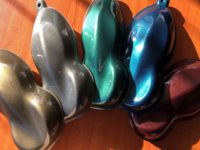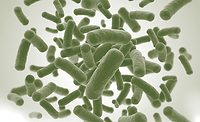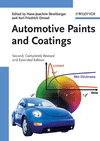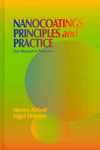
Market challenges and demand for brand and product differentiation continue to skyrocket as design professionals and product consultants wade through fields of new technologies, searching for that "different" coating and appearance strategy. Recent trends and the latest discoveries in the special-effect pigments market - especially for powder coatings systems and in liquid and plastics applications - have created a myriad of choices and, in turn, has opened up new avenues for bringing about change. Wacker -Chemie GmbH and its U.S.-based subsidiary Wacker Silicones Corp. has taken the lead in the battle for product and brand differentiation with the introduction of the HELICONE HC and HELIPLUS coating technologies.
HELICONE HC Pigments
HELICONE HC special-effect pigments create innovative, optically variable color effects based upon liquid crystal-modified organic molecules. Interference effects cause reflection of a certain spectral component of the incident light, with transmission of the remainder. There is no absorption of light in the visible spectrum. The base color (i.e., the color observed from face on) undergoes a strong color shift (flop) toward short wavelengths as the viewing angle changes or narrows (see Figure 1).The pigments consist of an organic polymer network comprising a so-called liquid crystalline phase. Liquid crystals (LCs) are molecules that enter a state of matter showing characteristics of both isotropic melt and the ordered crystal when heated above their melting point. In the LC state, the molecules are moving like a liquid but still exhibit degrees of molecular order normally only found in solid crystals. Consequently, some physical properties are angle dependent in the liquid crystalline state, including refractive index, thus adding unique optical properties to the system.
Several kinds of LC phase structures are known. The most common one, the nematic LC phase, is observed in the case of markedly stiff, cigar-shaped molecules. In their liquid crystalline state, the molecules are oriented along a director.
If a chiral compound (a molecule not superimposable on its mirror image) is added to such a nematic system, a helical superstructure formation occurs. A layered structure is formed with each layer having a slightly different orientation of the cigar-shaped molecules. If the direction or orientation is followed from layer to layer, a helix or twist of the director can be observed; that is why this cholesteric LC phase is also called a twisted nematic (see Figure 2).
The cigar-shaped liquid crystal molecules are fixed into layers or parallel rows, each row having a slightly different molecular orientation. Light falling upon the cholesteric helix is split into two parts. Most of the light is transmitted, but a small amount of light is reflected. The wavelength of the reflected light corresponds to the "pitch" (the distance between two layers of the same molecular orientation) of the cholesteric helix (see Figure 3). Each HELICONE HC particle typically has at least 10 pitches. This determines the wavelength of light being reflected. If the pitch lies between 400nm and 700nm, the reflected light can be perceived as color. The pitch of a cholesteric helix depends on the amount of chiral additive so that the wavelength of reflection can be turned arbitrarily by the amount of the chiral additive. The wavelength of reflected light changes continuously with the viewing angle, due to an interference effect of the cholesteric multilayer structure (see Figure 4).
In HELICONE HC pigments, a cholesteric phase is fixed by crosslinking. By this, the unique optical properties are maintained and can be used for highly desirable decorative effects. HELICONE HC pigments are therefore comprised of cigar-shaped platelet-type particles, which develop the best color effects when applied on a dark-colored substrate, or when mixed in dark jewel-tone values (see Figure 5). Inside the platelets, cholesteric helices are oriented with their axis perpendicular to the surface. Therefore, each platelet behaves like a small selective mirror. (It reflects light of a specific wavelength). When used in light values, unique semi-metallic effects can be generated which express hints of color travel. This metallic effect is especially desirable in waterborne applications where standard metallic pigments may have a tendency to generate dangerous levels of hydrogen gas. Although they are platelets, they are not as dependent on orientation as other special effect pigments due to their softer color transition.
HELICONE HC grades of pigments come in four standard colors and two standard particle sizes (see Figure 6).
- Sapphire - Royal Blue to Black or Invisible
- Scarabeus - Emerald Green to Electric Blue
- Jade - Deep Gold to Dark Green Jade
- Maple - Copper Red to Gold to Forest Green
All four grades have the identical chemical basis; only the amount of the chiral additive (which determines the helical pitch and consequently the color of the reflection) vary from grade to grade. This is a big advantage for the end user because the pigments have identical application properties regardless of their color.
HC and HC XL flakes, composed of rows of cigar-shaped molecules, are highly versatile due to their robust processing properties and attractive color features. They are easily dispersed and compatible with most binder systems including water, solvent, and powder vehicle systems. To bring out the best color effect, it is advisable to use transparent binders and other transparent ingredients, although unique effects can be obtained in opaque systems as well. To improve the opacity of a coating system containing HELICONE HC pigments, small amounts of fine aluminum flake and carbon black can be added.
Additional novel effects may be created by blending with other non-opaque colorants or special-effect pigments. The transparency of these materials allows for the creation of even more unusually appealing three-dimensional effects. When used in combination with the HELIPLUS glass mirrors and/or beads to generate what is termed a "bi-ocular" effect in two coat systems vs. other effect materials that call for three coat systems, an additional step to accomplish similar visual appearances is bypassed. Using a combination of HELICONE HC with the HELIPLUS glass mirrors and/or beads, an impressive visual depth to the coating is possible.
In most coating systems, improvements in adhesion and impact resistance are noticeable due to the "polymeric" nature of the liquid crystal pigments. The low specific gravity of the liquid crystal pigments means there is a very low tendency to settle, unlike most other special effect pigments. Their low specific gravity also allows less pigment (on a relative pigment weight basis) to be used to generate strong optical effects in comparison to standard mica- or aluminum-based optically variable pigments. Also, in powder coatings, the low density and organic nature bring about a very positive application profile; costly bonding procedures are not necessary. These facts help make coatings formulated with liquid crystals more economical and practical.
HELIPLUS Pigment Additives
In the current styling environment, where there is an emphasis to generate more cost-effective coatings in conjunction with the desire to recycle materials where possible, a new series of optical enhancers and pigment additives is available: HELIPLUS. These materials, when formulated into coatings, not only give unique color and appearance effects, but lower overall raw-material costs. In addition, the recycled glass and rubber products are qualified under the U.S. Federal Executive Order for Recycling and may qualify for federal tax credits.Formulators can look upon the glass substrate HELIPLUS additive as a dependency enhancer for both current metallic and special-effect pigments (such as HELICONE HC), for the creation of a soft glow, unlike the expected metallic sparkle. Such tools allow the formulator flexibility to engineer distinctive physical properties as well as unique appearance into existing formulations. The various HELIPLUS additives when used in coatings can significantly improve physical properties such as mar resistance or pattern control, or they can impart tactile properties, improve heat transfer, or provide heat resistance. Through new particle engineering processing, new types of geometry for glass and rubber particles are available that create many extraordinary and aesthetically pleasing effects. Additional research has indicated that there are other naturally occurring materials, which can expand this formulating space, and Wacker continues to evaluate these for incorporation into the HELIPLUS additive line.
When used in powder coatings formulations, the additives are post-added to the finished powder to develop the desired special effects. Incorporation into the pre-mix tends to encapsulate these materials and reduce their visual impact on the finished powder. Only recently, the addition of HELIPLUS Z-OS has provided impressive initial results on various improvement characteristics for the processing of tint bases and coatings containing these tint bases. In addition to its optical spacing character, where color saturation is improved by as much as 15% in some systems, the unique mineral structure has the distinct ability to act as a flow modifier. This is proving to be important in the development of clearcoat systems where the improvements in distinctness of image acid-etch-resistance and scratch-resistance is very desirable.
Conclusion
Effect pigments are by nature typically more expensive than conventional colorants with which they are used. HELICONE HC pigments and HELIPLUS additives have created a formulation space in which the synergy of these materials allow opportunity for reduced cost while developing new and unique appearance and performance characteristics. Rather than relying on color development strictly from the pigment itself, the appropriate use of the additive line can allow for greater color impact due to reflectivity and particle spacing.The emergence of liquid crystal pigments and special-effect additives, regardless of the intended application, truly allows formulators to gain access to tomorrow's generation of coloration technology today. With the ability to develop appearance opportunities within the limits of conventional application conditions, and at a reasonable price, HELICONE HC pigments and resistance additives open the door for obtaining dramatic improvements in performance and appearance.
For more information on pigments, contact Wacker Silicones Corp., 3301 Sutton Road, Adrian, MI 49221; phone 800/248.0063; fax 517/264.8246; visit www.wackersilicones.com; or Circle Number 76.






